California Packing Corporation emerged from the consolidation
of four companies which, in turn traced their roots back to dozens
of pioneer California firms. Among the new arrivals in 1850s from
the East Coast was a 24-year old Bostonian named Francis Cutting.
 His
instincts tell him there is opportunity enough in California for
an enterprising Yankee trader. The gold mining prospectors will
need provisioning, and eagerly will buy hermetically sealed goods.
Francis Cutting was aware of the process, now known as canning
that was invented in 1810 by a Frenchman Nicolas Appert. Appert
discovered a way to preserve and package foods which permitted
the products to be stored indefinitely at room temperature without
loss of nutrient value, flavor. The product could be consumed
without heating or other preparatory work and came neatly packaged
in a virtually indestructible but easy-to-open metal containers.
His
instincts tell him there is opportunity enough in California for
an enterprising Yankee trader. The gold mining prospectors will
need provisioning, and eagerly will buy hermetically sealed goods.
Francis Cutting was aware of the process, now known as canning
that was invented in 1810 by a Frenchman Nicolas Appert. Appert
discovered a way to preserve and package foods which permitted
the products to be stored indefinitely at room temperature without
loss of nutrient value, flavor. The product could be consumed
without heating or other preparatory work and came neatly packaged
in a virtually indestructible but easy-to-open metal containers.
Francis Cutting
By November 1858, Cutting has bought a half interest in a small
vinegar works in Gold Rush City and is packing pickles for the
local mining camps. There was some problem though, the high cost
of glass jars, which have to be imported from the East. He sold
his interest in the pickle business and rents a place on Sacramento
Street near Battery.
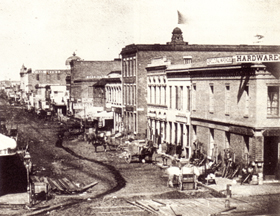
Cuttings 1st pack plant, c. 1860
With few hired hands the packing of pickles, cider, vinegar,
catsup, tomatoes and preserves begun under his own name. For the
next 39 years until the merger of the Cutting Fruit Packing Company
into one of Del Monte's predecessor companies,
Cutting business continues to prosper. Cutting was the first western
packer to introduce metal containers, the first to export California-grown-and-processed
fruit to the East coast and Europe.
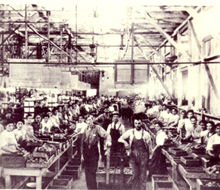
By 1899 Cutting Fruit Packing Company was operating plants in
San Francisco, Santa Ana, Colton and Santa Rosa. And has the assets
of $600,000. At the end of the century his business was absorbed
into the California Fruit Canners Association (CFCA).
Inside Cannery, c. 1880
The opening of the transcontinental railroad in 1869 brought
a new wave of western migration as hundreds of thousands of settlers
were attracted by the promise of cheap land, fair weather, and
"The California Dream".
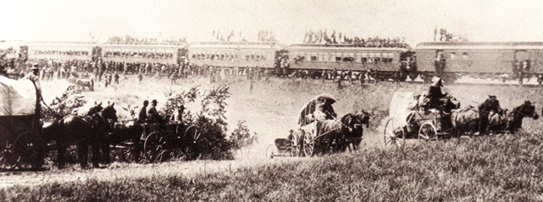
The early rail tariff limited the transporting canned food. Instead
it brought a new wave of migration of new settlers. Some took
up fruit and grape growing. Others were settled in agricultural
communities in Fresno, Merced, Modesto and Bakersfield. With its
year-around growing season and fertile soil, California had been
recognized as one of the great agricultural regions of the world.
Growers, then as now, needed canners, just as canners needed growers.
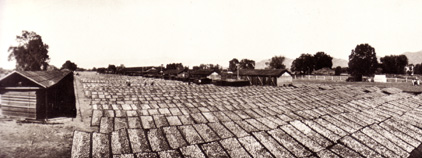 Preserving
the fruits by drying them in the sun was introduced by missionaries.
But it was not until the 1870s and 1880s that the commercial processing
of dried fruits and raisins begun.
Preserving
the fruits by drying them in the sun was introduced by missionaries.
But it was not until the 1870s and 1880s that the commercial processing
of dried fruits and raisins begun.
Peach-drying-yard, c. 1890
The dried fruit business was a major element of the early California
fruit and vegetable processing industry.
Griffin & Skelley, established in 1881, was one of the pioneers
in the commercial development of California's raisin and dried
fruit industry, and though it later engaged in canning as well,
it remained preeminently a dried fruit packer up to the time of
Calpak merger.
 It
happened that while vacationing at a hotel in Riverside, California,
in the summer of 1881, Griffin ran into an old friend, Seegar
who had recently retired there.
It
happened that while vacationing at a hotel in Riverside, California,
in the summer of 1881, Griffin ran into an old friend, Seegar
who had recently retired there.
Willard Griffin
Seegar asked Griffin if he ever considered go into business of
packing some of these fine Riverside oranges and shipping them
to east to market. Seegar would put up all the initial capital.
That day the great fruit packing enterprise of Griffin and Seagar
-later "Griffin & Skelley".
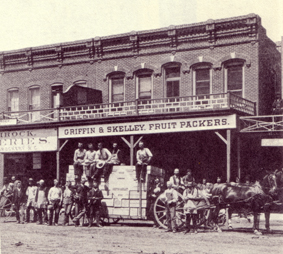
Griffin Skelley Calpacker, c. 1880
When Seegar died in 1884, E.R. Skelley joined the firm as partner
and manager of the Riverside orange packing operations.
They added raisins to its line and prunes. Griffin & Skelley
remained active in the orange packing business until around 1895
when Skelley retired and the Riverside operations were closed.

Griffin's two sons, Charles W. Sr. Griffin and Andrew G. Griffin,
assumed leadership of the company when he died in 1913, and became
officers and directors of California Packing Corporation following
the 1916 merger.
Charles W. Sr. Griffin and Andrew G. Griffin, c. 1916
I
In 1916 the merger of California Fruit Canners Association (CFCA),
Griffin & Skelley, Central California Canneries and J.K Armsby
Company, created California Packing Corporation. It began marketing
its products under the Del Monte brand. This brand name, however,
predates originated with one of CFCA's founders, the Oakland Preserving
Company. The Del Monte name comes from the Hotel Del Monte in
Monterey peninsula built in 1880 by millionaire Charlie Crocker,
and operated by the Southern Pacific Railroad.
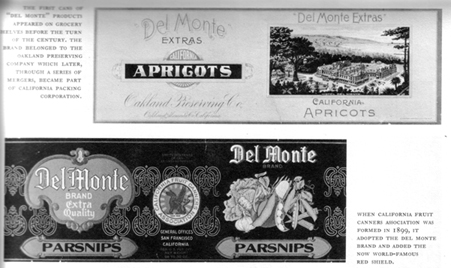
Del Monte Logo Shield, c. 1899
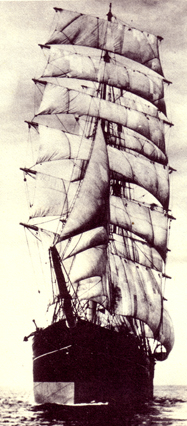 In
1916 the new company operated over 60 canneries including several
in Washington, Oregon, and Idaho. The San Francisco based Alaska
Packers Association processed salmon at its Alaska canneries.
In
1916 the new company operated over 60 canneries including several
in Washington, Oregon, and Idaho. The San Francisco based Alaska
Packers Association processed salmon at its Alaska canneries.
Alaska Ship Star of Finland
The company's star Fleet used to transport men and supplies
north each spring, then return them and the salmon pack in the
fall.
The square-rigger Bal Clutha berthed at Fisherman's Wharf is in
reality Alaska Packer Association's "Star of Alaska",
which was transporting salmon as late as 1930.
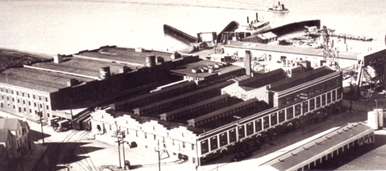
Plant Number One, Beach St. Cannery, San Francisco,
c. 1920
The cannery now is the collection of restaurants, shops near
Hyde Street Pier, was once Calpak's Plant Number One. It was closed
and sold during 1930s. The company always was sorry that they
didn't hang on some of the lucrative landmarks.
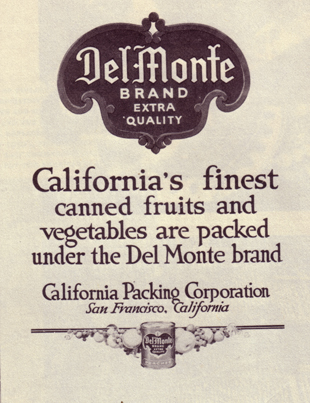 In
April 17, 1917 Saturday Evening Post, the first national ad for
Del Monte appeared.
In
April 17, 1917 Saturday Evening Post, the first national ad for
Del Monte appeared.
Del Monte First National advertisement, c. 1917
In 1967 the decision was made to change corporate name to Del
Monte Corporation.
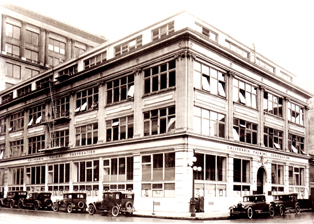
Armsby Building, 101 California Street, San Francisco, Calpak
headquarters from 1917 to 1950.
All administrative and marketing functions were centralized in
the Armsby Building at 101 California Street. James K. Armsby
was a president. Andrew G. Griffin and Charles W. Griffin, vice
presidents and co-founders.
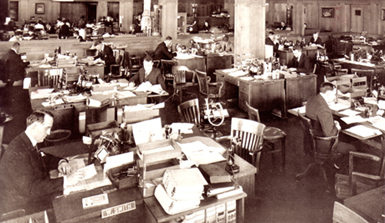
Calpak's Sales Dpt, c.1921
This is an account of Charles W. Griffin, Jr., Vice president
(retired), Del Monte Corporation.
During my college vacation in 1920 I got a job at Calpak's
Fresno Plant, 15-65 cents an hour for the first eight hours, 85
cents for the next four, and anything over 12 hours was $1.00.
Pretty good wages. When I graduated from college in 1922, I was
fortunate to get a job at Plant 12 in Sacramento - 40 cents per
hour and no overtime. I remember thanking, my dad for letting
me finish my education, but telling him I didn't think it did
much for my earning capacity.
Please click here for the
Part 2 of the presentation.